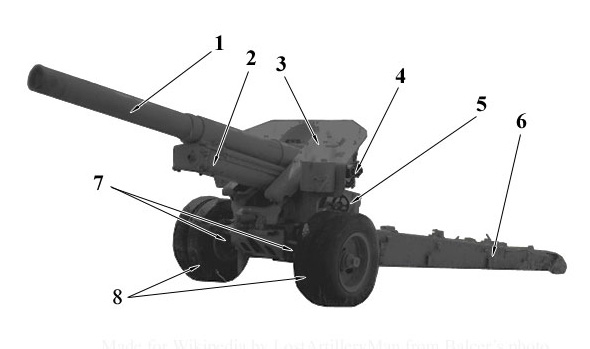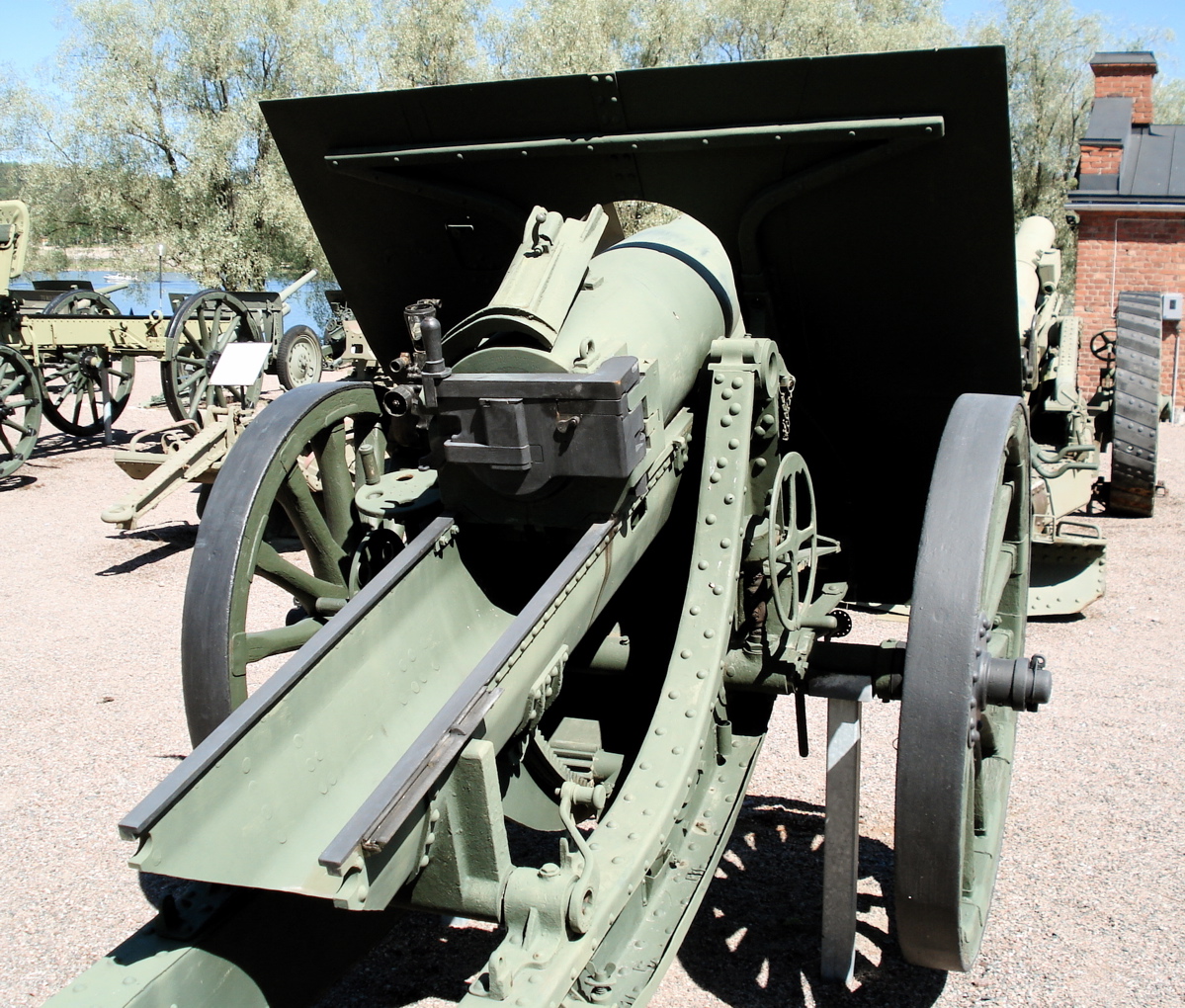|
152 Mm Howitzer M1938 (M-10)
152-mm howitzer M1938 (M-10) (russian: 152-мм гаубица обр. 1938 г. (М-10)) was a Soviet 152.4 mm (6 inch) howitzer of World War II era. It was developed in 1937–1938 at the '' Motovilikha Mechanical Plant'' by a team headed by F. F. Petrov. Although production of the gun was stopped in 1941, it saw combat with the Red Army until the end of World War II and remained in service until the 1950s. Captured pieces were used by Wehrmacht and the Finnish Army. The latter kept the M-10 in service until 2000. In a tank-mounted variant, M-10T, the gun was mounted on the KV-2 heavy tank. Development history By the early 1930s the Red Army (RKKA) started to look for a replacement for the 152-mm howitzer M1909 and the 152-mm howitzer M1910. Those pieces, developed before World War I, had unsprung fixed trail carriages and short barrels, which meant poor mobility, insufficient elevation and traverse angles and short range. Although both pieces were eventually modernized, ... [...More Info...] [...Related Items...] OR: [Wikipedia] [Google] [Baidu] |
USSR
The Soviet Union,. officially the Union of Soviet Socialist Republics. (USSR),. was a transcontinental country that spanned much of Eurasia from 1922 to 1991. A flagship communist state, it was nominally a federal union of fifteen national republics; in practice, both its government and its economy were highly centralized until its final years. It was a one-party state governed by the Communist Party of the Soviet Union, with the city of Moscow serving as its capital as well as that of its largest and most populous republic: the Russian SFSR. Other major cities included Leningrad (Russian SFSR), Kiev ( Ukrainian SSR), Minsk ( Byelorussian SSR), Tashkent (Uzbek SSR), Alma-Ata (Kazakh SSR), and Novosibirsk (Russian SFSR). It was the largest country in the world, covering over and spanning eleven time zones. The country's roots lay in the October Revolution of 1917, when the Bolsheviks, under the leadership of Vladimir Lenin, overthrew the Russian Provisional Gove ... [...More Info...] [...Related Items...] OR: [Wikipedia] [Google] [Baidu] |
152-mm Howitzer M1909/30
152 mm howitzer M1909/30 (russian: 152-мм гаубица обр. 1909/30 гг.) was a Soviet 152.4 mm (6 inch) howitzer, a modernization of the 152 mm howitzer M1909, initially designed by Schneider. It was the most numerous 152 mm howitzer employed by Red Army in World War II. Development and production history From the late 1920s the RKKA sought to upgrade its World War I-era artillery pieces. One of the modernized weapons was the 152 mm howitzer M1909, initially designed by the French arms manufacturer Schneider. After a number of experiments it was determined that the muzzle velocity of the piece could be increased to about 395 m/s (further increase could result in a damage to the carriage). In 1930 at the Bolshevik Plant, the gun was experimentally fitted with a muzzle brake. In 1930-1931, the Perm plant developed a modernization project. Initially, the only element of the project was lengthening the chamber to 340 mm (upgraded barrels received ... [...More Info...] [...Related Items...] OR: [Wikipedia] [Google] [Baidu] |
Breechblock
A breechblock (or breech block) is the part of the firearm action that closes the breech of a breech loading weapon (whether small arms or artillery) before or at the moment of firing. It seals the breech and contains the pressure generated by the ignited propellant. Retracting the breechblock allows the chamber to be loaded with a cartridge. Breechblocks are categorised by the type or design of the mechanism by which it is locked or closed for firing. The firearm action more fully refers to the mechanism by which the operator actuates the opening and closing of the breech. Variants A way of closing the breech or chamber is an essential part of any breech-loading weapon or firearm. Perhaps the simplest way of achieving this is a break-action, in which the barrel, forestock and breech pivot on a hinge that joins the front assembly to the rear of the firearm, incorporating the rear of the breech, the butt and usually, the trigger mechanism. A breechblock is a separate compon ... [...More Info...] [...Related Items...] OR: [Wikipedia] [Google] [Baidu] |
ZiS-5 (truck)
The ZIS-5 (russian: ЗИС-5) was a 4x2 Soviet truck produced by Moscow ZIS factory from 1932 to 1948 (first one made at the end of 1930). Development In 1931 Moscow Avtomobilnoe Moskovskoe Obshchestvo (AMO, Russian Автомобильное Московское Общество (АМО) — Moscow Automotive Enterprise) truck plant was re-equipped and expanded with the help of the American A.J. Brandt Co., and began to produce a new truck with designation of AMO-2. AMO-2 was intended as a replacement of the previous AMO-F-15, the first Soviet truck ever built (it was a copy of the Italian Fiat F-15). However, it was clear that the AMO F-15 was getting outdated, so they started producing the newer AMO-2 and AMO-3 trucks, that were based on the Autocar SD trucks, after a license agreement with the Autocar Company. In 1933 AMO was rebuilt again and renamed into Factory No. 2 Zavod Imeni Stalina (or Plant of Stalin's name, abbreviated in ZIS or ZiS) and in Summer, the AMO-2 an ... [...More Info...] [...Related Items...] OR: [Wikipedia] [Google] [Baidu] |
M10 Components
M1, M01 or M-1 may refer to: Arts, entertainment & media * WD-M01 Turn A Gundam, a mecha from the anime ''Turn A Gundam'' * M-1 (rapper), one half of hip hop duo Dead Prez * Korg M1, a keyboard synthesizer * Leica M1, a 1959 35 mm camera model * Olympus OM-1, a 1972 manually operated 35mm single-lens reflex camera * M1 (TV channel), news channel of the Hungarian MTVA * M-1 (Lithuanian radio station) * M1 (Ukraine), a television channel Economics and finance * M1 (money supply measure), in economics, a measure of the money supply * M1 Finance, an online financial services company Military equipment Vehicles US Armed Forces * M1 Abrams, a main battle tank * M1 Armored Car * M1 Combat Car, an early tank * M1 Light Tractor * M1 Medium Tractor * M1 Heavy Tractor Other * Bristol M.1, a 1916 British fighter aircraft * (M1), a WWI Royal Navy monitor * (1919), an early British submarine * , a Swedish Navy mine sweeper * , a Swedish Royal Navy mine layer Weapons US A ... [...More Info...] [...Related Items...] OR: [Wikipedia] [Google] [Baidu] |
152-mm Howitzer M1943 (D-1)
The D-1 howitzer M1943 (russian: 152-mm gaubitsa obr. 1943 g. (D-1)) is a Soviet World War II-era 152.4 mm howitzer. The gun was developed by the design bureau headed by F. F. Petrov in 1942 and 1943, based on the carriage of the 122 mm howitzer M1938 (M-30) and using the barrel of the 152 mm howitzer M1938 (M-10). The powerful and mobile D-1, with its wide range of ammunition, significantly increased the firepower and breakthrough abilities of Red Army tank and motor rifle formations. Several hundred D-1s were manufactured before the end of World War II. Post World War II, the D-1 saw combat in numerous conflicts during the mid- to late 20th century. The long operational history of D-1 howitzers in national armies of numerous countries is a testimony to its qualities; the gun still remains in service in a number of post-Soviet states and some other countries. The D-1 is widely considered a valuable element of Soviet artillery.Shunkov V. N. - The Weapons of the Red ArmySh ... [...More Info...] [...Related Items...] OR: [Wikipedia] [Google] [Baidu] |
Recoil
Recoil (often called knockback, kickback or simply kick) is the rearward thrust generated when a gun is being discharged. In technical terms, the recoil is a result of conservation of momentum, as according to Newton's third law the force required to accelerate something will evoke an equal but opposite reactional force, which means the forward momentum gained by the projectile and exhaust gases (ejectae) will be mathematically balanced out by an equal and opposite momentum exerted back upon the gun. In hand-held small arms, the recoil momentum will be eventually transferred to the ground, but will do so through the body of the shooter hence resulting in a noticeable impulse commonly referred to as a "kick". In heavier mounted guns, such as heavy machine guns or artillery pieces, recoil momentum is transferred to the Earth's surface through the platform on which the weapon is mounted. In order to bring the rearward moving gun to a halt, the momentum acquired by the gu ... [...More Info...] [...Related Items...] OR: [Wikipedia] [Google] [Baidu] |



.jpg)